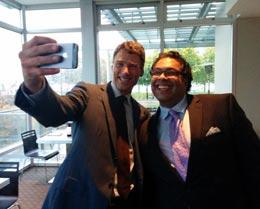Vancouver and Calgary: A tale of two cities

Guest Commentary
By Donald McInnes
Recently Canada 2020 hosted an event in Vancouver called “Cities as Nation Builders” featuring Mayors Robertson from Vancouver and Naheed Nenshi from Calgary. When I looked at the agenda I could not help consider the recent election advertisement of Mayor Robertson. He demands on one hand that the Federal and Provincial governments help Vision Vancouver pay for and build a subway line to UBC and in the same breath says he must protect us from the Trans Mountain Pipeline.
Everyone in Canada knows that Alberta does not have a provincial sales tax, is near the top in spending more per capita on health care and education and spends more capita on infrastructure than every single other province. How do they do this? I take comfort that Calgarians know, love and celebrate that they are a service and supply centre for the oil patch which gives governments the ability to pay and provide.
By now most Vancouverites will have noticed the crane that was erected at the Seaspan Shipyard in North Vancouver. To me it’s a powerful symbol of economic prosperity and advancement for the province that come from natural resource development.
After all, we have a proud heritage in BC of shipbuilding and coastal trade that has its roots in the movement of our natural resources from mine, well-head and forest to our trading partners. Seaspan’s $11-billion ship building contract will be another welcome jobs-generator for the Metro region.
Of course the resource sector goes beyond BC. Our nation was built on the extraction, development and sale of our natural resources. Led by Newfoundland and Labrador, Atlantic Canada continues to encourage natural resource development.
But Newfoundland’s shift in its status from ‘have not’ to ‘have’ in just one generation is truly remarkable. Two natural resource projects are at the core of this transformation; the Voisey Bay nickel mine was discovered in 1993 with production commencing in 2005 and oil production commenced at Hibernia in 1997. Today a new nickel processing plant is being built for $ 2 billion. It seems the Rock has a new attitude, and the sky’s the limit.
While some urban BC readers may see the direct relationship between a government’s ability to pay for health care and education and economic well-being many do not. Without growing government revenue, how can we expect to afford our robust system of social programs or things like a subway to UBC? Simple – we can’t.
In Alberta and most parts of Canada, the public often widely embraces natural resource development proposals, and creative solutions are sought to mitigate impacts. Not in BC. Here we too often assess all real, possible and perceived negative impacts and only then decide if the project should occur.
Imagine if the Confederation Bridge linking Prince Edward Island with mainland New Brunswick were built according to the same mindset. The project would have been impossible. As it happened, the construction of the fixed link triggered not one single authorization under the Fisheries Act. Yet in BC it seems the Fisheries Act is routinely triggered in order to hamstring just about every proposal that’s on the table.
Let me be very clear that I am not against regulation, nor are most of my resource sector colleagues. I’m simply arguing in favour of some sense of balance as we consider the most effective and appropriate regulation and oversight of our natural resources sector.
So please Mayor Robertson let’s celebrate natural resources development and build on it, not ignore it. Vancouver is home to over 850 mineral exploration and mining companies. A recent report by Resource Works BC found that just seven companies engaged in natural resource development annually buy goods and services valued at $1.3 billion from over 1,665 companies based in the GVRD.
Today Vancouver, British Columbia’s largest permanent clearcut, is more of a resource-based community than you might have thought. Calgarians know they live in a service supply center for the oil patch. The GVRD is really the same for northern mines, coastal trade, a traditional gas industry and an emerging LNG sector. It’s home to legions of engineers, financiers, planners, lawyers, accountants and environmental consultants and more. All reliant on a robust natural resource economy located well beyond the sea to sky corridor and the natural playground of urban British Columbians.
It’s ironic to wonder that if a proponent today applied for a permit to build the iconic Canadian National Railway the St Lawrence Seaway or closer to home the Tsawwassen Ferry Terminal – things we take for granted, could we get a permit to build them! Today I think these projects would likely be paralyzed by proscriptive rules and regulations, onerous public hearing requirements and attacks by well-funded environmental organizations.
It’s time for elected officials to celebrate our proud heritage of natural resource development and to ensure responsible natural resource development flourishes to provide for the quality of life we enjoy. We can build on that proud heritage and history and seek to attract clean tech and new age businesses but let’s not shut down the foundation of our society.
None of us can afford that.
Donald McInnes has an extensive background in mining and renewable energy ventures in BC and elsewhere. Based in Vancouver, he is a partner of Oxygen Capital Corporation.






